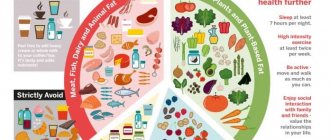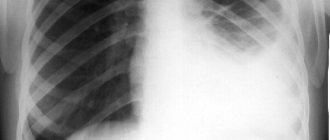When a child's temperature rises, a runny nose and cough begin, parents understand that it is most likely a cold. If your cheeks turn red or a rash appears, you may have an allergy. Well, the best way to tell about the state of a baby’s digestive system is his stool. But it’s not so easy to answer the question unequivocally of what a newborn’s stool should be like.
At birth, the newborn's intestines are cleared of meconium. These are sticky, odorless accumulations of black-green color, which indicate the normal functioning of the baby’s intestines. Afterwards, his stool depends on nutrition. We will tell you in the article what normal stool is like for a baby, why it comes in different colors and what “secrets” are hidden in a baby’s diaper.
The effect of food on baby's stool
from mother's milk changes color from dark green to golden green. This is a transitional feces, which is formed on the 3-5th day, until milk replaces colostrum. Afterwards, the stool is more uniform, acquires a yellow color, may have whitish lumps, and a faint smell of sour milk. It happens quite often. But we hasten to reassure parents: if the baby is gaining weight, then bowel movements after each feeding should not cause alarm. As the baby grows up, the stool will take shape and become denser and more regular.
Normal stool during breastfeeding:
- yellow, slightly greenish color;
- mushy consistency;
- sour smell;
- up to 6-10 bowel movements per day from birth, 1-2 times - closer to a year.
- greenish, yellowish-brownish;
- smear-like consistency;
- more pronounced odor;
- stool once every three days is also normal.
Normal stool color for a baby: shades of yellow, brown, green.
Feces on formula milk The less mixture in supplementary feeding, the yellower the stool. Babies who grow up on formula feeding have fewer bowel movements. And if there is no restless behavior, this indicates a high degree of nutritional absorption. Month after month, a child's stool will become more and more like an adult's stool.
Normal stool with artificial and mixed feeding:
From solid food, the stool changes even more towards the adult, it thickens and turns yellow-brown, but can take on the colors of the food that the child eats while the body adjusts to digesting new foods. Do not be afraid of introducing complementary foods; this is the norm for a cheerful and active baby. But we note the following: accumulations of white lumps of undigested food can “scream” about the introduction of complementary foods in too large volumes, which children’s digestion cannot completely cope with. But foamy, odorous stool with mucus already indicates that complementary feeding is started too early or that these products are not suitable.
How does complementary feeding affect a baby's stool?
- depending on the color of the food, the stool takes on different shades;
- the semi-liquid pulp becomes denser;
- possible increased colic, flatulence;
- vegetables usually cause loose stools, and cereals strengthen them.
An important point is that deviations from the usual frequency and appearance of stool do not always signal illness. And many parents have this experience. However, if changes worsen and new symptoms appear, please consult a doctor.
Colorless, black, blood-streaked stool, a lot of mucus and foam in the baby's stool - it is best to call an ambulance without waiting for a pediatrician's visit.
Reasons for changes in a small child's stool:
- insufficient maturity of the digestive organs, lack of enzymes;
- composition of food for a nursing woman;
- lack of breast milk;
- intolerance to infant formula, complementary foods;
- mother and child taking certain medications;
- physiological jaundice of the newborn;
- imbalance of intestinal microbiota;
- intestinal inflammation;
- viral, bacterial infections;
- food allergy.
Before the age of one year, green and yellow, looser or thicker stools can be either normal or pathological. Frequency and impurities that should not be in the stool of a healthy baby help to distinguish one condition from another.
When to worry and figure out what went wrong:
- white-gray or black stool;
- slurry mixed with mucus and blood;
- green watery stools with foam;
- bowel movements more than 12-15 times a day;
- rare stools: once every 3-5 days or less;
- completely liquid yellow stool with no solid particles;
- gagging in combination with diarrhea, fever;
- the child does not eat well, does not gain or loses weight;
- severe irritation and diaper rash in the diaper area;
- the child is uncommunicative, restless, and whiny.
Sleep norms by age
- 2 months: baby sleeps less now. During the day, as a rule, he rests 5 times, he has 2 long sleeps of 1–3 hours each and 3 short ones of 10–30 minutes each. It's convenient to take your baby out for a nap. At this age, the baby gets used to sleeping at night for 10–12 hours, with breaks for feeding. As a rule, a 2-3 month old baby’s sleep does not last more than 3-4 hours in a row, both day and night.
- 3 months: the overall daily routine depends on sleep. As a rule, a child sleeps 16–17 hours a day: 10 hours at night and 5–7 hours during the day. These are 2 long sleeps of 1–2 hours each and 2 short ones of 30–40 minutes each. The baby needs 20 - 30 minutes to fall asleep, and he requires his mother's breast for this.
- 4 – 6 months: The baby now has his own routine. During the day he rests 3–4 times (from 30 minutes to 2 hours), falls asleep and wakes up at approximately the same time, and sleeps longer at night.
Green stool in a newborn
Why a baby has green stools cannot be answered with certainty. Unnaturally green stools against the background of increased gas formation and a body rash can signal disturbances in the intestinal microflora and dysbacteriosis. Green, foamy stool in infants is often associated with lactose intolerance. Stools containing staphylococci and streptococci will also be green and foamy. When an infection occurs, the baby usually vomits, has a fever, and suffers from intestinal colic, and the first aid in this case will be an urgent medical examination. Medicinal mixtures and iron supplements also give the stool a greenish tint.
Hiccups
How does it express itself?
In the first months of life, almost all children hiccup; moreover, the baby begins to hiccup in the womb. Simply due to the contraction of the diaphragm separating the abdomen and chest cavity, the baby’s breathing is impaired. As a result, it makes a characteristic loud sound. There's no need to worry. As a rule, hiccups go away within 10 to 15 minutes.
Causes:
- Thirst - the baby’s mucous surface of the mouth and digestive canal dries out;
- Strong emotions - a child may be frightened by a loud sound, a sudden flash of bright light or an unexpected touch;
- Overeating - food, stretching the ventricle, causes contraction of the diaphragm.
How to help your baby:
- Don't overfeed;
- If hiccups prevent your baby from sucking or falling asleep, you can give him some warm boiled water or baby herbal tea;
- If, as a result of hiccups, the baby burps and then continues to hiccup, hold him vertically in your arms for several minutes until breathing is restored. Do not place your baby on his or her back in the crib immediately after eating.
Causes of diarrhea in infants
Loose stools are not typical for healthy children, with the exception of newborns and infants of the second or third month. If at this age the child is calm, eats and sleeps well, and his weight gain is normal, then loose stools are not a cause for concern. Diarrhea can be caused by antibiotics, infectious diseases, early or excessive introduction of juices into the diet.
If diarrhea occurs during the introduction of a new product, then the product is canceled, and breastfeeding or artificial feeding is maintained. Alarming symptoms - apathy and drowsiness from dehydration, quiet and weak crying of the child - are beyond the norm and should be discussed with a doctor.
Advertising
Organization of breastfeeding
To prevent the appearance of green stools and provide the baby with the necessary nutrients, you need to properly organize breastfeeding. To do this, the expectant mother needs to visit specialists during pregnancy and study this issue.
Treatment of dysbiosis in children
There are several rules for breastfeeding:
- First of all, you need to properly place the breast in the baby's mouth. It should capture not only the nipple, but also the areola, with the nose touching the breast.
- When sucking, no air whistling should be heard, and the mother should not feel pain.
- Breastfeeding should be done at the baby's request. There is no need to feed by the hour. The baby should suckle as much as he wants; the breast should not be taken away from him, otherwise he will not receive enough hind milk.
- For the same reason, you should not change breasts while breastfeeding. If you do this, the baby will only suck foremilk from both breasts. If the child is often attached to the breast, it is recommended to use one for 2 hours, then another for 2 hours.
- Mom needs to eat a balanced, varied diet. But you can’t change your diet suddenly. New foods should be introduced gradually and the child’s reaction should be observed.
It is very important that a woman who is breastfeeding eats properly, then the baby’s digestion will be normal
Causes of constipation in a newborn
Constipation in a newborn is often physiological; it occurs due to the immaturity of the digestive system and unformed reflex bowel movements. And it doesn't need to be treated. But if independent stool is absent for three days or more, the tummy is tense, the child pushes hard and cries, and has lost his appetite, then this is constipation, which is no longer the norm.
According to doctors, constipation from breast milk is rare, for example, when the baby is malnourished. This is also a typical condition on artificial nutrition, especially in the first ten days of introducing the formula, while the body adapts to foreign milk protein. However, thanks to the improvement of production technologies and the approximation of the contents of infant formula to the composition of breast milk, the stool of children on IV may be the same as that of breastfed children.
Immediately after birth
When the baby is in the mother's tummy, he receives all the necessary substances and microelements through the umbilical cord. The baby's digestive system is not working, but his stomach is not empty. The baby sucks his fingers, opens his mouth and thus swallows a small amount of amniotic fluid. When the baby is born, this substance will be in his intestines and will gradually be released as the baby is applied to the breast and his digestive system begins its work.
So, the baby’s first stool is meconium: dark feces with the consistency of plasticine. This is how the baby recovers for the first day or two. Sometimes this gives him unpleasant sensations: the baby worries, cries, strains before he manages to relieve himself. However, this is not always the case - many children recover easily, only by slightly pushing.
If everything is fine with the baby, he was put to the breast on time and fed on demand, then his stool gradually changes. On the third to fifth day, the baby has the so-called “transitional stool”, partly consisting of meconium, which is still in the gastrointestinal tract, partly from digested colostrum and milk. As a rule, first streaks appear in the meconium mass, then the stool gradually turns yellow. By the end of the first week, the baby's stool usually takes on the characteristics of a normal baby: yellow, rather liquid.
When should you worry? If the baby does not lose weight in the first two days, you should consult a doctor. There are children with individual characteristics who will continue to do this less often than most children. However, the cause of stool retention must be determined by a doctor. If the baby has some kind of problem with intestinal patency, help will be needed immediately, but you should not diagnose your baby without a doctor.
How to normalize your baby's stool
In case of diarrhea, severe constipation, pathological inclusions in the stool, redness and microcracks around the baby's anus, it is important to contact a medical facility or call a doctor at home. You should not buy medications yourself to solve the problem. Even a regular enema, gas tube and suppositories for constipation are given for medical purposes.
You should also not try to change the mixture yourself - you may need nutritional therapy. When offering a mixture, the doctor expects a specific effect from it and takes into account the composition of the formula: microelements in forms digestible by infants, the presence of ingredients that improve intestinal microbiota and digestion, for example, milk fat, prebiotics and probiotics. MAMAKO® baby food made with goat milk meets these expectations. It is not suitable for children with a confirmed allergy to milk protein, but in general, the digestion process with goat milk is easier, which contributes to the formation of soft stools - the baby is in a good mood, is interested in toys, actively communicates, and sleeps peacefully.
On the MAMAKO® website, pediatricians talk about how newborn digestion works. There you can also download the “What’s in a baby’s diaper” leaflet.
Choosing a diaper
You need to make sure that the diaper is the right size, otherwise it will not absorb well and will cause anxiety to the baby. Babies have very sensitive skin, and any discomfort greatly bothers them. It's best to buy several different types of diapers to see which is best. We talk in detail about what they are like here. What should you pay attention to first?
- On the packaging you will find numbers indicating the approximate weight of children: 3 – 6 kg, 4 – 9 kg, 9 – 18 kg, etc. Of course, these are approximate values, because the baby, for example, may be taller and thinner than A “standard” baby will need a diaper that is designed for a smaller baby.
If your child weighs 5 kg and you don’t know what size will suit him, try trying on “neighboring” diaper options for him - 3 - 6 kg and 4 - 9 kg. One of them will probably be preferable.
What is lactase deficiency
Breast milk contains everything a baby needs: easily digestible protein, calcium, fat-soluble vitamins, and fats and carbohydrates.
However, not all babies digest milk well. The most common cause is lactase deficiency, when the gastrointestinal tract cannot digest lactose - milk sugar, a complex of glucose and galactose, which makes up about 85% of all carbohydrates in breast milk.
Why does a child need lactose?
Lactose is the main sugar in a newborn’s diet, providing about 40% of its total energy expenditure.
Lactose and lactase
Lactose cannot be absorbed in the intestines in its pure form. First, it must be broken down into glucose and galactose molecules using the enzyme lactase. Its deficiency leads to impaired breakdown of lactose. This causes milk intolerance and is called “lactase deficiency.”
Causes:
- Congenital lactase deficiency is the complete inability of the newborn’s intestines to produce lactase. This is a very rare disease that develops due to a mutation in the genes responsible for the production of lactase.
- Transient lactase deficiency, a temporary inability to produce lactase, is common in many premature babies. This usually goes away within a few months after birth.
- Acquired lactase deficiency is caused by intestinal diseases. It usually develops in children suffering from food allergies, intestinal infections, and gluten intolerance. Once the disease is cured, the intestines' ability to produce lactase is completely restored.
How to recognize lactase deficiency? Symptoms of lactase deficiency:
- Very frequent watery stools;
- Allergic skin rash;
- True constipation (thick stool that is difficult to pass);
- Bloating;
- Excessive gas formation and colic.
You should contact your pediatrician and do a series of tests, based on which he will prescribe treatment.
Massage for colic
It is recommended to massage your baby's tummy before each feeding. For best results, massage after using a heating pad for five minutes. You can heat the diaper with an iron or hold it on a warm radiator, then put it on the baby’s stomach, cover it with your hands and hold it for a while. There is no need to lubricate your hands with oil or cream.
- Lightly stroke your belly in a clockwise direction. Make about 10 turns.
- Then alternately bend and unbend his legs, pressing them to his stomach. Do this for 6–8 repetitions with each leg.
- Turn the baby over onto his tummy and make several stroking movements from the sides and over the pelvic bones in the direction from the stomach to the lower back.











